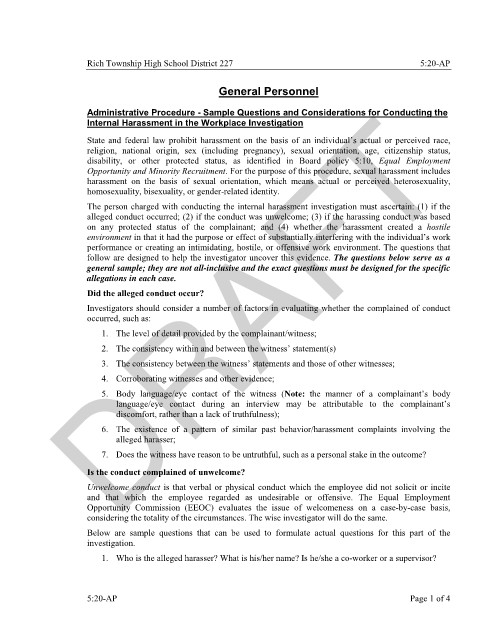Page 894 - draft
P. 894
Rich Township High School District 227 5:20-AP
General Personnel
DRAFT
Administrative Procedure - Sample Questions and Considerations for Conducting the
Internal Harassment in the Workplace Investigation
State and federal law prohibit harassment on the basis of an individual’s actual or perceived race,
religion, national origin, sex (including pregnancy), sexual orientation, age, citizenship status,
disability, or other protected status, as identified in Board policy 5:10, Equal Employment
Opportunity and Minority Recruitment. For the purpose of this procedure, sexual harassment includes
harassment on the basis of sexual orientation, which means actual or perceived heterosexuality,
homosexuality, bisexuality, or gender-related identity.
The person charged with conducting the internal harassment investigation must ascertain: (1) if the
alleged conduct occurred; (2) if the conduct was unwelcome; (3) if the harassing conduct was based
on any protected status of the complainant; and (4) whether the harassment created a hostile
environment in that it had the purpose or effect of substantially interfering with the individual’s work
performance or creating an intimidating, hostile, or offensive work environment. The questions that
follow are designed to help the investigator uncover this evidence. The questions below serve as a
general sample; they are not all-inclusive and the exact questions must be designed for the specific
allegations in each case.
Did the alleged conduct occur?
Investigators should consider a number of factors in evaluating whether the complained of conduct
occurred, such as:
1. The level of detail provided by the complainant/witness;
2. The consistency within and between the witness’ statement(s)
3. The consistency between the witness’ statements and those of other witnesses;
4. Corroborating witnesses and other evidence;
5. Body language/eye contact of the witness (Note: the manner of a complainant’s body
language/eye contact during an interview may be attributable to the complainant’s
discomfort, rather than a lack of truthfulness);
6. The existence of a pattern of similar past behavior/harassment complaints involving the
alleged harasser;
7. Does the witness have reason to be untruthful, such as a personal stake in the outcome?
Is the conduct complained of unwelcome?
Unwelcome conduct is that verbal or physical conduct which the employee did not solicit or incite
and that which the employee regarded as undesirable or offensive. The Equal Employment
Opportunity Commission (EEOC) evaluates the issue of welcomeness on a case-by-case basis,
considering the totality of the circumstances. The wise investigator will do the same.
Below are sample questions that can be used to formulate actual questions for this part of the
investigation.
1. Who is the alleged harasser? What is his/her name? Is he/she a co-worker or a supervisor?
5:20-AP Page 1 of 4

